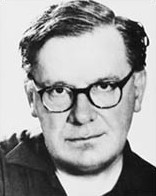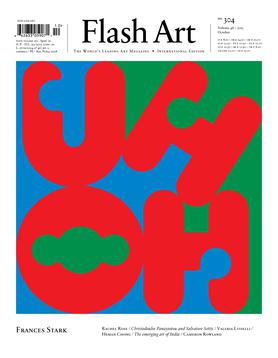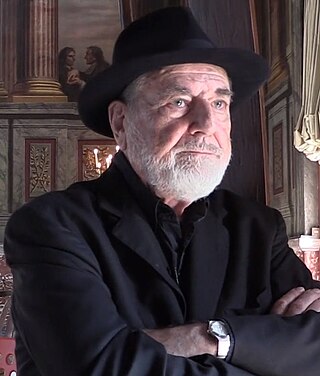
Arte Povera was an art movement that took place between the end of the 1960s and the beginning of the 1970s in major cities throughout Italy and above all in Turin. Other cities where the movement was also important are Milan, Rome, Genoa, Venice, Naples and Bologna. The term was coined by Italian art critic Germano Celant in 1967 and introduced in Italy during the period of upheaval at the end of the 1960s, when artists were taking a radical stance. Artists began attacking the values of established institutions of government, industry, and culture.

Jannis Kounellis was a Greek Italian artist based in Rome. A key figure associated with Arte Povera, he studied at the Accademia di Belle Arti in Rome.
Lydia Venieri is a Greek artist.
Germano Celant was an Italian art historian, critic, and curator who coined the term "Arte Povera" in the 1967 Flash Art piece "Appunti Per Una Guerriglia", which would become the manifesto for the Arte Povera artistic and political movement. He wrote many articles and books on the subject.

Nikos Egonopoulos was a Greek painter and poet. He is one of the most important members of "Generation of the '30s", as well as a major representative of the surrealist movement in Greece. His work as a writer also includes critique and essays.

Flash Art is a contemporary art magazine, and an Italian and international publishing house. Originally published bilingually, both in Italian and in English, since 1978 is published in two separate editions, Flash Art Italia (Italian) and Flash Art International (English). Since September 2020, the magazine is seasonal, and said editions are published four times a year.

Modern Greek art is art from the period between the emergence of the new independent Greek state and the 20th century. As Mainland Greece was under Ottoman rule for all four centuries, it was not a part of the Renaissance and artistic movements that followed in Western Europe. However, Greek islands such as Crete, and the Ionian islands in particular were for large periods under Venetian or other European powers' rule and thus were able to better assimilate the radical artistic changes that were occurring in Europe during the 14th-18th century.
Miltos Manetas is a Greek painter and multimedia artist. He currently lives and works in Bogotá.

Alexander Iolas was an Egyptian-born Greek-American art gallerist and significant collector of modern art works, who advanced the careers of René Magritte, Andy Warhol and many other artists. He established the modern model of the global art business, operating successful galleries in Paris, Geneva, Milan and New York.

The Museum of Contemporary Art Andros is a museum located in Andros, Greece.

Michelangelo Pistoletto is an Italian painter, action and object artist, and art theorist. Pistoletto is acknowledged as one of the main representatives of the Italian Arte Povera. His work mainly deals with the subject matter of reflection and the unification of art and everyday life in terms of a Gesamtkunstwerk.
Denys Zacharopoulos is an art historian and theorist. He works as Professor of Art History, author, and curator, amongst others at the 48th Biennale in Venice (Italy) and documenta IX in Kassel (Germany).
Countess Adelina von Fürstenberg-Herdringen is a Swiss curator specialized in contemporary art. Von Fürstenberg was one of the first curators to show an interest in non-European artists, thus opening the way for a multicultural approach in art. She also took a more global and flexible approach to contemporary art exhibitions, in bringing art into spaces such as monasteries, madrasas, large public buildings, squares, islands, and parks. Her objective is to give a larger context for visual art in making it a more vigorous part of our lives, in creating a more vivid dialogue for it with other arts, and relating it more to worldwide social issues.
Marisa Merz was an Italian artist and sculptor. In the 1960s, Merz was the only female protagonist associated with the radical Arte povera movement. In 2013 she was awarded the Golden Lion for Lifetime Achievement at the Venice Biennale. She lived and worked in Turin, Italy.
ART for The World is a non-governmental organization (NGO) associated with the United Nations Department of Public Information (UNDPI). It is based in Geneva, Switzerland, and since 2005 has collaborated with its sister association ART for The World Europa, based in Milan, Italy. In 1995, Adelina von Fürstenberg founded ART for The World within Dialogues de Paix, an international contemporary art exhibition which she curated on the occasion of the 50th anniversary of the United Nations.
Tatjana Ilic – Tanja Ilic is a fine artist. She graduated from the Faculty of Fine Arts – Majoring in graphics in Belgrade in 1995. During her studies she enrolled at the Düsseldorf Arts Academy in the class of Jannis Kounellis, section Bildhauerei. On the recommendation of her professor, she acquired a Master's status in 1997, and continued to work in the same class until 2000. She has been a member of the Association of Fine Artists of Serbia since 1995. She has also been a member of the International Artists Forum since 2003. In the same year her artwork "Vogel" was incorporated into the analytical review "Performance – Art – Kontext".

Stephen Antonakos was a Greek born American sculptor most well known for his abstract sculptures often incorporating neon.
Athanasios Argianas is a Greek and British artist living and working in London, England. Argianas' practice is interdisciplinary; incorporating sculpture, painting, text, performance and often music or sound, and concerns itself with metaphorical or translated representations of aural experiences. He received his MA from Goldsmiths College, London and previously studied under Jannis Kounellis at the Kunstakademie Düsseldorf.
Matteo Montani is a contemporary Italian painter and sculptor born in Rome in 1972.









